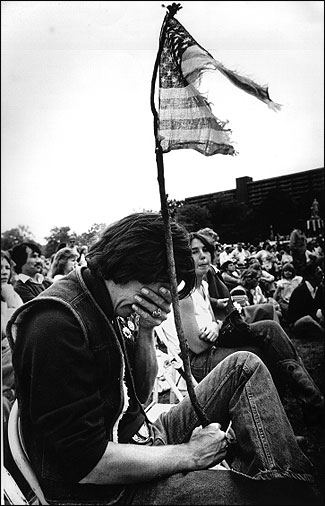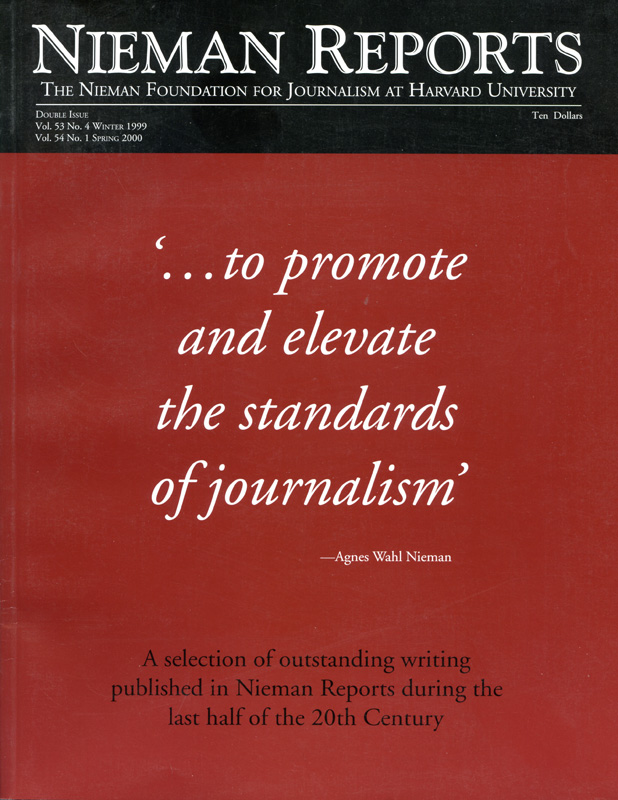
Scott Summer, a former Vietnam medic, holds the tattered flag taken from the grave in Vietnam of his best friend and weeps during a star-spangled salute to Vietnam veterans. Photo by Bill Welch, courtesy of The (Nashville) Tennessean.
[This article originally appeared in the Winter 1982 issue of Nieman Reports.]
Through the viewfinder of my camera I could see people looking sympathetically at the Vietnam veteran, tears in his eyes, the tattered American flag in his hand.
His very private moment was on public view—and I was photographing that moment for thousands of newspaper readers. I was depicting his personal sadness, his inner pain, his solitary reminiscence of his experiences in Vietnam.
I had come to Centennial Park that day, October 4, 1981, to observe and to photograph events as Nashville paid its salute to the near-forgotten veterans of a controversial war.
By chance I had come across this former soldier who was consumed by the hurtful impact of remembering lost friends and shattered dreams.
I have no idea how other photojournalists feel at such moments, but I suspect that no matter how experienced or “professional” they are, somewhere within them there is something of what I felt: a sense of intruding on an almost embarrassingly intimate time.
Suddenly I sensed the mood of other people nearby.
I was “news media” preying on grief, exploiting tragedy, exposing the raw nerve of sadness. I was a “flesh fly.”
Through the viewfinder I could see people glaring at me as if I was committing some obscene act.
I understood what my job was. I had come to this huge gathering in the park to try to capture on film the essence of the community’s day of tribute to veterans who had been denied even words of thanks for what they had done for our country.
The point of the assignment, ideally, was to give thousands of newspaper subscribers, through their viewing of photographs, a means of understanding and even sharing what this event was all about.
The picture of the suffering of Scott Summer—the veteran I was photographing—symbolized that day for me. It was a day of mixed emotions, a celebration with tears.
I attended that day with a good deal of personal curiosity, as well as a journalistic interest. I wondered, given the complexity of the issues surrounding the war, what form this salute would take. How would the city honor veterans of a war most citizens were trying to forget? How would veterans, who strongly feel their service had been demeaned and who believe society wanted to forget them, react to the day?
I had not gone to Vietnam. I had been just the right age. I had tried to go and had been turned down for physical reasons. But I experienced that time at home. For my part, I never want to forget about it.
In the park that day I was struck by the military hardware on display. There seemed to me to be irony at the sight of children climbing at play all over an M-60 tank. By chance I bumped into a friend, and I expressed surprise at the presence of the military weaponry.
“It was just part of the war,” he said, “just like the men who were there.”
There were special events—a helicopter taking off and a paratrooper from the 101st Airborne parachuting to earth, an American flag streaming behind him. There was music, and there was speechmaking.
A Tattered Flag
I worried inwardly about “celebrating war.” I took pictures of what was going on, the speechmakers, the parachutist, the children on the tank. But still I was looking for a single scene that would communicate the symbolism of this unique funereal festival.
Then I saw a man waving that small tattered flag. There was an isolated presence about him—a man alone in a crowd. I began to photograph him, attempting not to invade what seemed to me to be his reverie of controlled misery.
As some participants in the ceremony were retiring the colors, I approached him to ask his name, address and something about his service in Vietnam.
Scott Summer was friendly. The ragged flag had belonged to his best friend, Kenny Brown, he said. They had come from Fort Scott, Kansas, and joined the army together. Kenny was a door gunner on a helicopter; Scott, a medic.
Kenny had been killed November 3, 1970—Scott’s birthday. On this day Kenny was on Scott’s mind. Scott was remembering times when the two of them would get together in Vietnam. Scott loved chocolates; Kenny loved beer. They would meet and swap beer and chocolates—and enjoy talking about home.
Somehow, Scott said, he did not feel that he was “home” from Vietnam yet. It was, this day, almost as if he were still in Vietnam. Tears welled up in his eyes. He started to cry. Again, I began to photograph him.
He put his head in his hand. The drama of the moment peaked. I stopped photographing.
I said good-bye. I had the picture that to me symbolized the day. I should have been happy. Somehow, as I walked to my car, I didn’t like myself very much.
Driving back to the newspaper I tried to evaluate why I felt that way. I knew that what I had on film was powerful. If anything could move people to understand the Vietnam veteran’s situation—first rejected, then forgotten but still clinging to what remained of national idealism—it was the picture of Scott Summer.
But how would Scott and those who had been around him feel when they viewed the photograph, knowing that I had taken advantage of his most vulnerable moment?
Reaction From the Veteran
The picture ran on the front page the next morning—and the response was immediate.
The Associated Press selected it and sent it out to newspapers in other cities. It made the front page in Boston, and a reporter called to ask how I had come to take it. Locally, people began to telephone me. Two women who said they lost friends in Vietnam asked me to send them copies of the picture.
Then Scott Summer called. His voice was warm. He said he appreciated the picture. It had helped him to see himself weeping publicly. His attitude made me choke up. I started crying on the phone. Scott said the torn flag expressed the way he and many other veterans felt—“torn and dilapidated inside.”
Journalists need to care about what they do and about people they deal with in covering the news. Since that experience with Scott Summer I have reflected on other assignments.…
A Glimmer of Truth
Most journalists I know reject the idea that “bad news is good news.” But bad news is news. And pictures that vividly portray real-life scenes of tragedy are part of that news. They tell us how acts of violence threaten to consume us.
That is less than profound. But as long as such photographs provide at least a glimmer of human truth, I will continue to make them, believing that society needs to be reminded regularly of its dark side—unless and until I am consumed by the feeling that I am not a photojournalist but a “flesh fly.”
Bill Welch, with The Tennessean in Nashville, has been a newspaper photographer for eight years. Prior to that, he was in urban planning. This article first appeared in The Tennessean and was also published in the Gannetteer. It appears here with permission; © The Tennessean.


